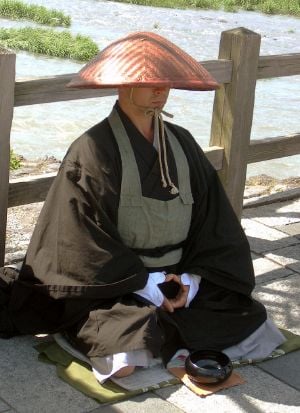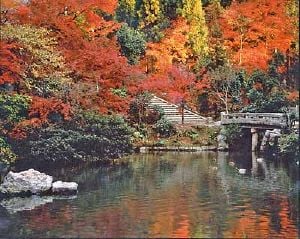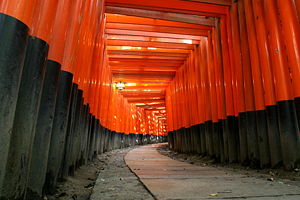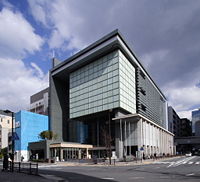Kyoto
| Location of Kyoto City Kyoto City's location in Kyoto prefecture, Japan. | |
| Location | |
| Country | Japan |
| Region | Kansai |
| Prefecture | Kyoto prefecture |
| Physical characteristics | |
| Area | 827.90 km² |
| Population (as of March 2006) | |
| Total | 1,473,068 |
| Density | 1779/km² |
| Symbols | |
| Tree | Weeping Willow, katsura |
| Flower | Camellia, Azalea, Sugar Cherry |
| Symbol of Kyoto City Symbol of Kyoto City | |
| Kyoto City Hall | |
| Mayor | Yorikane Masumoto |
| Address | 〒604-8571 Kyoto-shi, Nakagyo-ku, Teramachi-Oike, 488 |
| Phone number | 075-222-3111 |
| Official website: Kyoto City | |
- This article is about the city Kyoto. For the prefecture Kyoto, see Kyoto Prefecture. For the convention, see Kyoto Protocol.
Kyōto (京都市 Kyōto-shi) (lit. “capital capital,” or “capital of capitals”) is a city in Japan, which has a population close to 1.5 million. Formerly the imperial capital of Japan, it is now the capital of Kyoto Prefecture, as well as a major part of the Osaka-Kobe-Kyoto metropolitan area.
History
Though archaeological evidence places the first human settlement on the islands of Japan to approximately 10,000 B.C.E., relatively little is known about human activity in the area before the 6th century AD. During the 8th century, when the powerful Buddhist clergy became meddlesome in the affairs of the Imperial government, the Emperor chose to relocate the capital to a region far from the Buddhist influence.
The new city, Heiankyō (平安京 "Heian capital") became the seat of Japan's imperial court in 794. Later, the city was renamed to Kyoto ("capital city"). Kyoto remained Japan's capital until the transfer of the government to Edo in 1868 at the time of the Imperial Restoration. (Some believe that it is still the legal capital: see Capital of Japan.) After Edo was renamed to Tokyo (meaning "Eastern Capital"), Kyoto was known for a short time as Saikyo (西京 Saikyō, meaning "Western Capital").
An obsolete spelling for the city's name is Kiouto; it was formerly known to the West as Meaco or Miako (Japanese: 都; miyako "capital"). Early 17th century Portuguese called it Miyaco or Miaco[1].
Although there was some consideration by the United States of targeting Kyoto with the atomic bomb at the end of World War II, in the end it was decided to remove the city from the list of targets. (See Atomic bombings of Hiroshima and Nagasaki)
Kyoto is the only large Japanese city that still has an abundance of prewar buildings, such as machiya (traditional townhouses). However, modernization is continually breaking down the traditional Kyoto in favor of newer architecture, such as the controversial Kyoto Station complex.
Kyoto became a city designated by government ordinance on September 1, 1956. In 1997, Kyoto hosted the conference that resulted in the protocol on greenhouse gas emissions that bears the city's name.
A common English pronunciation of Kyoto has three sounds as key-oh-toe; however, the Japanese pronunciation is kyoh and to (listen ▶).
Geography
Kyoto is located on the middle-western portion of the island of Honshū. Due to the surrounding mountains on all sides, Kyoto is famous for its stifling summer nights with no air movement.
The original city (the modern-day wards of Nakagyō, Shimogyō, and Kamigyō) was laid out in a grid pattern (modeled after the ancient Chinese capital during the Tang Dynasty, Changan (present-day Xi'an)) in accordance with traditional Chinese geomancy, with the Imperial Palace facing south. The Imperial Palace's southward orientation is also the reason why Sakyō-ku (the "Left Capital") is in the east, Ukyō-ku (the "Right Capital") is in the west. Today, the main business district is located in the south and center of town, with the less populated northern area retaining a far greener feel. Surrounding areas do not follow the same grid pattern as the center of the city, though streets throughout Kyoto share the distinction of having names (as Japanese streets typically are not named).
Kyoto is surrounded on three sides by mountains known as Higashiyama, Kitayama and Nishiyama, with a height just under 1000 meters above sea level.
Kyoto sits above a large natural water table that provides the city with ample freshwater wells. Due to large scale urbanization, the amount of rain draining into the table is dwindling and wells across the area are drying at an increasing rate.
Wards

Kyoto has eleven wards (ku).
Demographics
As of 2005, the city has an estimated population of 1,474,764 and a population density of 1,775 persons per km². The total area is 827.90 km².
Culture
Kyoto is considered the cultural center of Japan. During World War II when firebombing was conducted throughout the country, Kyoto and its 1600 Buddhist temples, 400 Shinto shrines, palaces, gardens and architecture were spared, leaving it one of the best preserved cities in Japan. The Kyoto area has some of the most famous temples, shrines, palaces and gardens in Japan, including:
- Kiyomizu-dera, a magnificent wooden temple supported by pillars off the slope of a mountain;
- Kinkaku-ji, the Golden Pavilion;
- Ginkaku-ji, the Silver Pavilion;
- Heian Jingū, a Shinto shrine celebrating the Imperial family (built in 1895);
- Ryōan-ji, famous for its rock garden;
- Kyoto Imperial Palace, home of the Emperors of Japan for many centuries;
- Katsura Imperial Villa, one of Japan's finest architectural treasures;
- Shugaku-in Imperial Villa, one of Japan's best Japanese gardens.
Other notable sites in and around Kyoto include Arashiyama and its picturesque lake, the Gion and Pontochō geisha quarters, the Philosopher's Walk, and the canals which line some of the older streets.
The "Historic Monuments of Ancient Kyoto" are listed by the UNESCO as a World Heritage Site. These include the Kamo Shrines (Kami and Shimo), Kyō-ō-Gokokuji (Tōji), Kiyomizu-dera, Daigo-ji, Ninna-ji, Saihō-ji (Kokedera), Tenryū-ji, Rokuon-ji (Kinkaku-ji), Jishō-ji (Ginkaku-ji), Ryōan-ji, Hongan-ji, Kōzan-ji and the Nijo Castle. Other sites outside the city are also on the list.
Kyoto is renowned for its abundance of delicious ethnic foods and cuisine. The history of Kyoto have allowed to retain a variety of vegetables.
Economy
Tourism forms a large base of Kyoto's economy. The city's cultural heritages are constantly visited by school groups from across Japan, and many foreign tourists also stop in Kyoto.
The city's industry is mainly comprised of small plants, most of which are run by artisans who produce traditional Japanese crafts. Kyoto's kimono weavers are particularly renowned, and the city remains the premier center of kimono manufacturing. Such businesses, vibrant in past centuries, have declined in recent years as sales of traditional goods stagnate.
Kyoto's only sizable heavy industry is electronics: the city is home to the headquarters of Nintendo, as well as the headquarters of OMRON, Kyocera (Kyoto Ceramic) and Murata Machinery. The apparel giant Wacoal also operates in Kyoto. However, the growth of high-tech industry has not outpaced the decline in traditional industry, and as a result, Kyoto's total output has declined relative to other cities in Japan.
Kyoto used to be known as Japan's Hollywood with Toei Uzumasa Eigamura. [1] The Eigamura (also known as Kyoto Studio Park and Toei Movie Land) is also called the "Hollywood of Japan." Many Japanese period movies were shot here. Like Universal Studios, Eigamura is a film set and theme park in one. It features traditional Japanese buildings replica which are used as setting for period movies and TV dramas. Including a replica of the old Nihonbashi Bridge, a traditional court house, a Meiji Period police box and part of the former Yoshiwara red light district. Actual film shooting takes place occasionally, and park visitors are welcome to observe the action.
Other attractions include various performances, a haunted house, a large souvenir shop and exhibitions about popular TV series. Dress up and get photographed service is also available. The choice ranging over 30 attires including samurai, shinsengumi, geisha and ninja attires. The cost varies from 8500 to 16000 Yen. This is certainly a tourist spot not to be missed. [2]
Colleges and universities
Kyoto is known as one of the academic centers of the country, and is home to thirty-seven institutions of higher education. The three largest and best-known local universities are Doshisha University, Kyoto University, and Ritsumeikan University. Among them, Kyoto University is considered to be one of the top universities in Japan, with several Nobel laureates, for example Yukawa Hideki.
Kyoto also has a unique higher education network called the Consortium of Universities in Kyoto, which consists of 3 national, 5 public (prefectural and municipal), and 41 private universities, as well as the city and 4 other organizations. The consortium does not offer a degree; hence is not a federal body like University of London, but offers the courses as part of a degree at participating universities.
Transportation
The city transportation is centered around Kyoto Station (京都駅, Kyoto-eki?). The station is the 2nd largest in Japan and holds a shopping mall, hotel, movie theater, Isetan department store, and several local government facilities under one fifteen-story roof. The Tokaido Shinkansen Line (see below) as well as all local rail lines conect here. For many travelers its is a hub of travel and a good place to catch all the buses the city has to offer.
The bus network is the only practical way of reaching many attractions. Most city buses have a fixed fare of ¥220, but you can also purchase a one day pass (¥500 for adults and 250 yen for children under 12) with which you can ride an unlimited number of times within a one day period. The day passes can be bought from the bus drivers or from the bus information centre just outside the Kyoto Station. This is especially useful if you plan on visiting many different points of interest within Kyoto. You can also buy a combined unlimited train and bus pass for ¥1200.
Unlike most Japanese buses, Kyoto's buses have announcements and electronic signs in English. The municipal transport company publishes a very useful leaflet called Bus Navi. It contains a route map for the bus lines to most sights and fare information. You can pick it up at the information center in front of the main station.
The Tōkaidō Shinkansen provides passenger rail service linking Kyoto with Nagoya and Tokyo (in one direction) and with nearby Osaka and points west (in the other direction). The trip from Tokyo takes just over two hours. Another way to access Kyoto is via Kansai International Airport. The Haruka Express carries passengers from the airport to Kyoto Station in 72 minutes. There is also frequent service on JR, Keihan Railway, Hankyu Railway, Kintetsu, and other lines to other cities in the Kansai region.
Kyoto's municipal bus network and subway system (see Kyoto Municipal Transportation Bureau) are extensive. Private carriers also operate within the city. Many tourists join commuters on the public buses, or take taxis or tour buses.
Cycling forms a very important form of personal transportation in the city, to an extent that bicycle culture can be considered a part of Kyoto's urban identity. The geography and scale of the city are such that the city may be easily navigated on a bicycle.
The streets of central Kyoto form a grid. Many large east-west avenues have numbers. Kyoto Station lies between Shichijo and Hachijo (shichi means "seven" and hachi means "eight). Major north-south roads have names such as Karasuma and Horikawa. Kyoto Station is on Karasuma, and the subway system's Karasuma Line follows that street north and south from the station, with stops at many numbered avenues, and also at Imadegawa (a major street). The other line, the Tozai Line, runs east-west partly under Oike Street.
Festivals
| 15 May | Aoi Matsuri |
| June to 17 July | Gion Matsuri, culminating in a massive parade. |
| 16 August | Gozan Okuribi |
| 22 October | Jidai Matsuri. |
Sports
In football (soccer), Kyoto is represented by Kyoto Purple Sanga who rose to J. League's Division 1 in 2005. With the popularity of the nearby Hanshin Tigers, Kyoto has never had a team in Japanese professional baseball, though the Tigers play several neutral-site games at Kyoto's Nishi Kyogoku stadium every year.
Additionally, Kyoto's high school baseball teams are strong, with Heian and Toba in particular making strong showings recently at the annual tournament held in Koshien Stadium, Nishinomiya, near Osaka.
Sister cities
 Boston, Massachusetts, United States
Boston, Massachusetts, United States Paris, France
Paris, France Cologne, Germany
Cologne, Germany Prague, Czech Republic
Prague, Czech Republic Florence, Italy
Florence, Italy Kyiv, Ukraine
Kyiv, Ukraine Xi'an, People's Republic of China
Xi'an, People's Republic of China Guadalajara, Mexico
Guadalajara, Mexico Jinju, Republic of Korea
Jinju, Republic of Korea Zagreb, Croatia
Zagreb, Croatia
Reference: Sister and Other Associated Cities, Kyoto's official web site.
External links
- Travel guide to Kyoto from Wikitravel
- Official site of Kyoto City (In English)
- Kyoto Podcast
- Kyoto view A site that shows nature of Kyoto
- Kyoto Gallery Photos from over 20 popular locations in Kyoto
Notes
- ↑ Rodriguez, João (1604). Arte da Lingoa de Iapam.
Template:Kyoto
Regions
Hokkaidō ·
Tōhoku ·
Kantō ·
Chūbu
(Hokuriku • Kōshin'etsu • Tōkai • Chūkyō) ·
Kansai ·
Chūgoku ·
Shikoku ·
Kyūshū ·
Ryūkyū
Prefectures
Aichi ·
Akita ·
Aomori ·
Chiba ·
Ehime ·
Fukui ·
Fukuoka ·
Fukushima ·
Gifu ·
Gunma ·
Hiroshima ·
Hokkaidō ·
Hyōgo ·
Ibaraki ·
Ishikawa ·
Iwate ·
Kagawa ·
Kagoshima ·
Kanagawa ·
Kōchi ·
Kumamoto ·
Kyōto ·
Mie ·
Miyagi ·
Miyazaki ·
Nagano ·
Nagasaki ·
Nara ·
Niigata ·
Ōita ·
Okayama ·
Okinawa ·
Ōsaka ·
Saga ·
Saitama ·
Shiga ·
Shimane ·
Shizuoka ·
Tochigi ·
Tokushima ·
Tōkyō ·
Tottori ·
Toyama ·
Wakayama ·
Yamagata ·
Yamaguchi ·
Yamanashi
Designated cities
Special wards of Tokyo ·
Chiba ·
Fukuoka ·
Hamamatsu ·
Hiroshima ·
Kawasaki ·
Kitakyushu ·
Kobe ·
Kyoto ·
Nagoya ·
Niigata ·
Osaka ·
Saitama ·
Sakai ·
Sapporo ·
Sendai ·
Shizuoka ·
Yokohama
| |||||||
ar:كيوتو bg:Киото ca:Kyoto cs:Kjóto da:Kyoto de:Kyōto et:Kyōto el:Κιότο es:Kioto eo:Kioto eu:Kioto fr:Kyōto gl:Quioto - 京都市 ko:교토 시 id:Kyoto os:Киото it:Kyoto he:קיוטו ka:კიოტო la:Kyotum lt:Kiotas nl:Kyoto (stad) ja:京都市 no:Kyoto pl:Kioto pt:Quioto (cidade) ro:Kyoto ru:Киото, Киото simple:Kyoto sl:Kjoto sr:Кјото fi:Kioto sv:Kyoto vi:Kyoto tr:Kyoto uk:Кіото zh:京都市
Credits
New World Encyclopedia writers and editors rewrote and completed the Wikipedia article in accordance with New World Encyclopedia standards. This article abides by terms of the Creative Commons CC-by-sa 3.0 License (CC-by-sa), which may be used and disseminated with proper attribution. Credit is due under the terms of this license that can reference both the New World Encyclopedia contributors and the selfless volunteer contributors of the Wikimedia Foundation. To cite this article click here for a list of acceptable citing formats.The history of earlier contributions by wikipedians is accessible to researchers here:
The history of this article since it was imported to New World Encyclopedia:
Note: Some restrictions may apply to use of individual images which are separately licensed.




